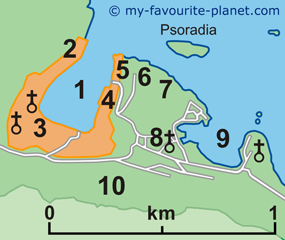The dragon is depicted here as a small serpent (often referred to as a "worm" in Medieval times) and does not appear to be a particularly dangerous or worthy foe. Compare it to highly graphic representation of the ferocious beast in the Saint George icon in Agios Georgios Tou Pigadiou (Saint George of the Well) on Kastellorizo's main harbour, on gallery page 97.
Agios Georgios (Saint George whose name means "worker of the land", i.e. farmer), the patron saint of Greece, chivalry, England, Georgia and many other places, is undoubtedly Kastellorizo's favourite holy man and there are at least five churches and chapels dedicated to him on the tiny island (for example Agios Georgos tou Horafiou in the Horafia district), not to mention the chapel on the islet of Agios Georgios off the coast of Mandraki harbour (see photos of Mandraki on gallery pages 223 and 224).
According to Christian tradition, Saint George (circa 275/281 – 23 April 303) was of Christian parents and became a tribune in the army of Roman Emperor Diocletian. In 302 AD the emperor ordered the arrest of all Christian soldiers. During a confrontation with Diocletian, who knew George and his father personally, George asserted his Christian belief and refused to obey the emperor's edict to worship pagan gods. Despite Diocletian's offers of wealth and subsequently torture, George held steadfast to his faith and was executed by decapitation. His martyrdom is said to have inspired many Romans to convert to Christianity, and after George's body was returned to Lydda in Palestine his tomb became a place of pilgrimage.
The dragon Saint George slew has come to symbolically represent the "evil one" (Satan), paganism and by extension non-Christian religions such as Islam. In the centuries of struggle between Christian and Muslim countries, this symbolism was constantly employed to encourage Christian resistance to Arab and Turkish military expansionism.
It is therefore not surprising that an isolated island such as Kastellorizo, uncomfortably much closer to its age-old foe Turkey than to any of its Greek neighbours, should have such a strong attachment to the symbolic strength of the Saint George legend.
See also photos of the 19th century church of Agios Georgios Tou Pigadiou (Saint George of the Well) on Kastellorizo's main harbour, including its interior and icons, on
gallery pages 83 - 141.
Kastellorizo Archaeological Museum
For information about the museum's history
and opening hours, see
gallery page 187.
| |

Map detail: Kastellorizo harbour
|
1 main harbour of Megisti
2 police station, post office, municipal hotel
3 Agios Georgios church, Nikolaos Stamatiou school, travel agent
4 ferry landing, harbour police, tourist information, bank, duty free
5 coast guard, mosque, path to Lycian tomb
6 Megisti museum, path to Lycian tomb
7 Knight’s Castle, Saints Nicholas & Dimitrios, hamam, windmill
8 Horafia, Platea Panagia, churches, Santrapeia school, Despina sculpture,Taverna Mediterraneo
9 Mandraki harbour and cemetery
10 stairs to clifftop view |